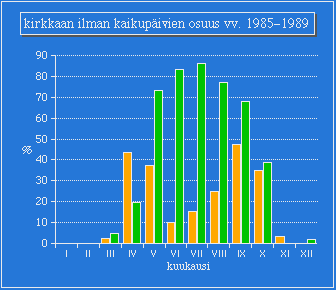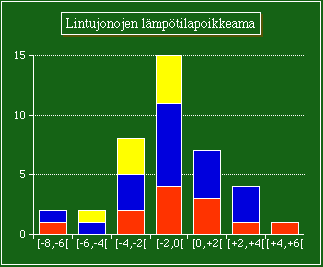On the occurrence of clear air echoes, and especially echoes from birds
Matti Leskinen 1998-01-21
 The figure on the right shows the percentage of clear air echo observations in the days the radar of the Department of Meteorology has been operated. The green columns tell the percentage of echoes related mainly to insects in the air and yellow columns the days when a substancial amount of birds caused some of the echoes.
The figure on the right shows the percentage of clear air echo observations in the days the radar of the Department of Meteorology has been operated. The green columns tell the percentage of echoes related mainly to insects in the air and yellow columns the days when a substancial amount of birds caused some of the echoes.
Birds are most frequently observed during migration periods in the spring and in autumn. Doppler weather radar can measure the radial speed of a bird i.e. how fast it is moving towards the radar or away from it. Using the radial speeds gathered at different azimuths an estimate of the mean speed vector can be calculated, and during bird migration the result is the speed and direction of migration in reference to ground. If the wind can be separately determined it is possible to find out the mean air speed and heading of the birds as well. An example of this kind of calculus has been done during
autumn migration in 1997
.
The radar measured Doppler spectra of land birds migrating during the night have showed that these species (including passerines etc.) seem to be flying alone with considerable distances between individual birds. However, in practice the spatial resolution of the radar (of the order of 100 m) may be too poor to completely separate individual migrators.
 The picture on the left shows the observed daytime temperature during line type bird echo days compared to the daytime temperature of all clear air echo days. Birds are often seen in lines that are connected to gust fronts (yellow) on the edge of the outflow region of a thunder cloud, organized convection (blue) often seen also as cumulus cloud streets, and sea-breeze fronts (red) on the limit of maritime air carried landwards by sea-breeze circulation.
The picture on the left shows the observed daytime temperature during line type bird echo days compared to the daytime temperature of all clear air echo days. Birds are often seen in lines that are connected to gust fronts (yellow) on the edge of the outflow region of a thunder cloud, organized convection (blue) often seen also as cumulus cloud streets, and sea-breeze fronts (red) on the limit of maritime air carried landwards by sea-breeze circulation.
Generally the situations that have significant amount of birds causing echoes in line type areas are relatively cooler. In the case of gust fronts this may be related to the effect of rain showers on daytime temperature. On the other hand the relative coolness of these days leads to smaller amount of insects in the air, which in turn congregates insect feeding birds to best areas to get food. The convergence zones of the mesometeorological phenomena are therefore the best choices for these birds.
It has to be remembered that the radar echoes are always related to birds some hundreds of metres above ground. For a ground level bird watcher the bands in the radar may not be of any importance, though gust fronts with swifts, swallows, and martins have been observed for instance by me in many occasions.
Change page to:
[clear air echoes]
[Matti Leskinen]
[Department of Meteorology]